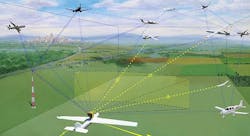Aviation authorities to brief industry this fall on UAV sense-and-avoid technologies
LAUREL, Md., 27 June 2014. U.S. government aviation authorities will meet with industry this fall to discuss lightweight sense-and-avoid technologies to enable unmanned aerial vehicles (UAVs) to operate safely with manned aircraft in crowded civil airspace.
Representatives of the U.S. Department of Defense (DOD), Federal Aviation Administration (FAA), National Aeronautics and Space Administration (NASA) and the Department of Homeland Security (DHS) will meet with industry to discuss UAV sense-and-avoid technologies on 28 and 29 Oct. 2014 at the John Hopkins Applied Physics Laboratory in Laurel, Md.
Sponsoring the event is the UAS Executive Committee -- a partnership of the DOD, FAA, NASA, and DHS. At this event government officials will hear presentations from industry on UAV sense-and-avoid technologies under development, and will brief attendees on government research on sense-and-avoid algorithm metrics and how to define safe separation distances between manned and unmanned aircraft. UAS stands for unmanned aerial systems.
Related: Navy chooses RDRTec to develop common sense-and-avoid radar for Fire Scout and Triton UAVs
In preparation for these meetings, officials of the UAS Executive Committee are asking for industry briefs on technologies that can reduce cost, size, weight, and power consumption of UAV sense-and-avoid systems on fixed-wing and helicopter UAVs.
Committee members particularly are interested in technologies under development in industry that can reduce the cost, size, weight, and power for onboard detection of aircraft that not communicating with air traffic control authorities, such as radar, light detection and ranging (lidar), or other sensor technologies.
Authorities also are interested in design and performance standards to help UAVs participate in air traffic control systems; detection technologies that may be adapted to UAV sense and avoid; beyond-line-of-site sense-and-avoid technologies; processes to reduce certification costs of sense-and-avoid hardware and software for UAVs; and sensor-fusion technologies for several dissimilar surveillance sources.
Related: Air Force surveys industry for companies able to design UAV common sense-and-avoid system
Companies interested in submitting sense-and-avoid technology presentations for consideration should email proposals no later than 22 Aug 2014 to Courtney Holbrook at [email protected]. Email questions or concerns to Holbrook at the same address. All presentations must be unclassified.
More information is online at https://www.fbo.gov/spg/ODA/WHS/REF/UASSSA/listing.html.

